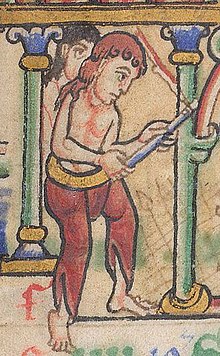
Yule is a winter festival historically observed by the Germanic peoples that was incorporated into Christmas during the Christianisation of the Germanic peoples. In present times adherents of some new religious movements celebrate Yule independently of the Christian festival. Scholars have connected the original celebrations of Yule to the Wild Hunt, the god Odin, and the heathen Anglo-Saxon Mōdraniht. The term Yule and cognates are still used in English and the Scandinavian languages as well as in Finnish and Estonian to describe Christmas and other festivals occurring during the winter holiday season. Furthermore, some present-day Christmas customs and traditions such as the Yule log, Yule goat, Yule boar, Yule singing, and others may have connections to older pagan Yule traditions.
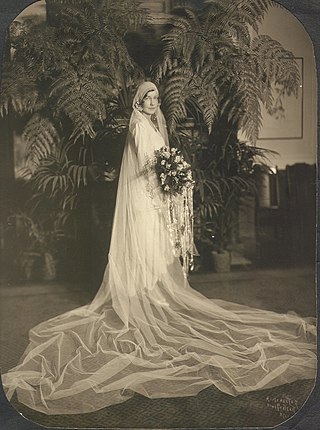
A bride is a woman who is about to be married or who is a newlywed.
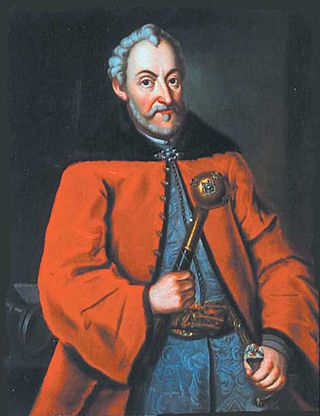
Żupan is a long lined garment of West or Central Asian origin which was widely worn by male nobles in the multi-ethnic Polish–Lithuanian Commonwealth and by the Ukrainian Cossacks in the Cossack Hetmanate. It was a typical upper class male attire from the late 16th to the first half of the 18th century.

A kaftan or caftan is a variant of the robe or tunic. Originating in Asia, it has been worn by a number of cultures around the world for thousands of years. In Russian usage, kaftan instead refers to a style of men's long suit with tight sleeves.
The Germanic language family is one of the language groups that resulted from the breakup of Proto-Indo-European (PIE). It in turn divided into North, West and East Germanic groups, and ultimately produced a large group of mediaeval and modern languages, most importantly: Danish, Norwegian, and Swedish (North); English, Dutch and German (West); and Gothic.

A tunic is a garment for the body, usually simple in style, reaching from the shoulders to a length somewhere between the hips and the knees. The name derives from the Latin tunica, the basic garment worn by both men and women in Ancient Rome, which in turn was based on earlier Greek garments that covered wearers' waists.
The verb go is an irregular verb in the English language. It has a wide range of uses; its basic meaning is "to move from one place to another". Apart from the copular verb be, the verb go is the only English verb to have a suppletive past tense, namely went.
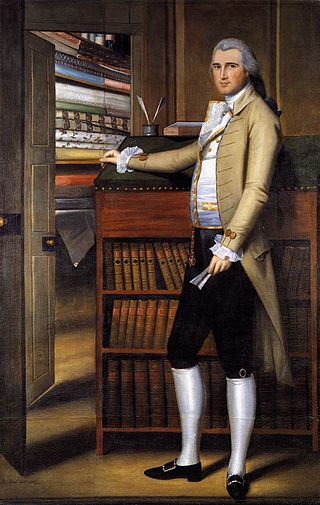
Breeches are an article of clothing covering the body from the waist down, with separate coverings for each leg, usually stopping just below the knee, though in some cases reaching to the ankles. Formerly a standard item of Western men's clothing, they had fallen out of use by the mid-19th century in favour of trousers.
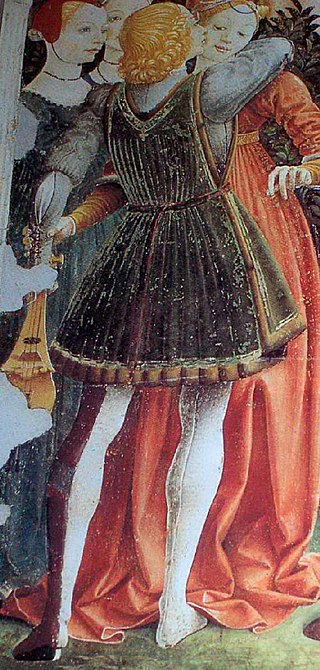
Hose are any of various styles of men's clothing for the legs and lower body, worn from the Middle Ages through the 17th century, when the style fell out of use in favour of breeches and stockings. The old plural form of "hose" was "hosen". In German these terms remained in use and are the generic terms for trousers today. The French equivalent was chausses.

Serbian traditional clothing, also called as Serbian national costume or Serbian dress, refers to the traditional clothing worn by Serbs living in Serbia, Croatia, Bosnia and Herzegovina, Montenegro, and the extended Serbian diaspora communities in Austria, Australia, Bulgaria, Canada, France, Germany, Greece, Hungary, North Macedonia, Romania, Russia, Slovenia, United States, etc. Like any traditional dress of a nation or culture, it has been lost to the advent of urbanization, industrialization, and the growing market of international clothing trends. The wide range of regional folk costumes show influence from historical Austrian, Hungarian, German, Italian, and Ottoman Turkish presence. Nonetheless, the costumes are still a pinnacle part of Serbian folk culture. From the 19th century and onwards, Serbs have adopted western-styled clothing. This change has started in larger settlements such as cities and towns, although it was not uncommon to see rural women in traditional working costumes all the way until the end of 1970s. Today, these national costumes are only worn by some elderly in rural areas but are most often worn with connection to special events and celebrations, mostly at ethnic festivals, religious and national holidays, weddings, tourist attractions, and by dancing groups who dance the traditional Serbian kolo, or circle dance.

Braccae is the Latin term for "trousers", and in this context is today used to refer to a style of trousers made from wool. According to the Romans, this style of clothing originated from the Gauls.

The kokoshnik is a traditional Russian headdress worn by women and girls to accompany the sarafan. The kokoshnik tradition has existed since the 10th century in the ancient city Veliky Novgorod, part of Kievan Rus' then. It spread primarily in the northern regions of Russia and was very popular from 16th to 19th century. It is still to this day an important feature of Russian dance ensembles and folk culture and inspired the Kokoshnik style of architecture.
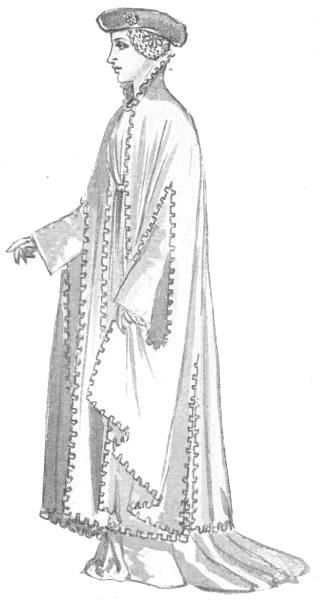
A houppelande or houpelande is an outer garment, with a long, full body and flaring sleeves, that was worn by both men and women in Europe in the late Middle Ages. Sometimes the houppelande was lined with fur. The garment was later worn by professional classes, and has remained in Western civilization as the familiar academic and legal robes of today.

Fashion in 15th-century Europe was characterized by a series of extremes and extravagances, from the voluminous robes called houppelandes with their sweeping floor-length sleeves to the revealing doublets and hose of Renaissance Italy. Hats, hoods, and other headdresses assumed increasing importance, and were draped, jeweled, and feathered.

Fashion in fourteenth-century Europe was marked by the beginning of a period of experimentation with different forms of clothing. Costume historian James Laver suggests that the mid-14th century marks the emergence of recognizable "fashion" in clothing, in which Fernand Braudel concurs. The draped garments and straight seams of previous centuries were replaced by curved seams and the beginnings of tailoring, which allowed clothing to more closely fit the human form. Also, the use of lacing and buttons allowed a more snug fit to clothing.

Costume during the thirteenth century in Europe was relatively simple in its shapes, rich in colour for both men and women, and quite uniform across the Roman Catholic world as the Gothic style started its spread all over Europe in dress, architecture, and other arts.

Twelfth century European fashion was simple in cut and differed only in details from the clothing of the preceding centuries, starting to become tighter and more similar for men and women as the century went on, which would continue in the 13th century. Men wore knee-length tunics for most activities, and men of the upper classes wore long tunics, with hose and mantle or cloaks. Women wore long tunics or gowns. A close fit to the body, full skirts, and long flaring sleeves were characteristic of upper-class fashion for both men and women.

Early medieval European dress, from about 400 AD to 1100 AD, changed very gradually. The main feature of the period was the meeting of late Roman costume with that of the invading peoples who moved into Europe over this period. For a period of several centuries, people in many countries dressed differently depending on whether they identified with the old Romanised population, or the new populations such as Franks, Anglo-Saxons, Visigoths. The most easily recognisable difference between the two groups was in male costume, where the invading peoples generally wore short tunics, with belts, and visible trousers, hose or leggings. The Romanised populations, and the Church, remained faithful to the longer tunics of Roman formal costume, coming below the knee, and often to the ankles. By the end of the period, these distinctions had finally disappeared, and Roman dress forms remained mainly as special styles of clothing for the clergy – the vestments that have changed relatively little up to the present day.

Trousers, slacks, or pants are an item of clothing worn from the waist to anywhere between the knees and the ankles, covering both legs separately. In the United Kingdom, the word pants generally means underwear and not trousers. Shorts are similar to trousers, but with legs that come down only to around the area of the knee, higher or lower depending on the style of the garment. To distinguish them from shorts, trousers may be called "long trousers" in certain contexts such as school uniform, where tailored shorts may be called "short trousers" in the UK.
The Medieval period in England is usually classified as the time between the fall of the Roman Empire to the beginning of the Renaissance, roughly the years AD 410–1485. For various peoples living in England, the Anglo-Saxons, Anglo-Danes, Normans and Britons, clothing in the medieval era differed widely for men and women as well as for different classes in the social hierarchy. The general styles of Early medieval European dress were shared in England. In the later part of the period, men's clothing changed much more rapidly than women's styles. Clothes were very expensive and both the men and women of lower social classes continued also divided social classes by regulating the colors and styles these various ranks were permitted to wear. In the early Middle Ages, clothing was typically simple and, particularly in the case of lower-class peoples, served only basic utilitarian functions such as modesty and protection from the elements. As time went on the advent of more advanced textile techniques and increased international relations, clothing gradually got more and more intricate and elegant, even with those under the wealthy classes, up into the renaissance.

